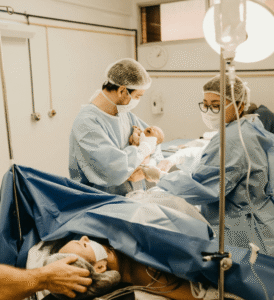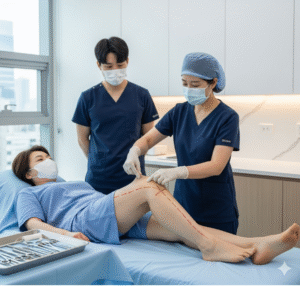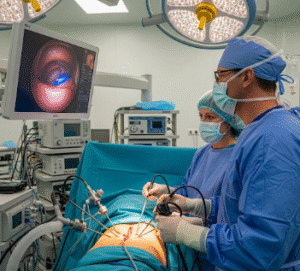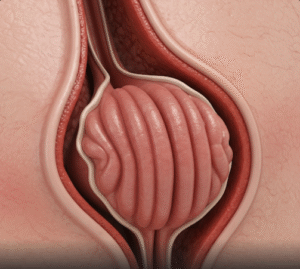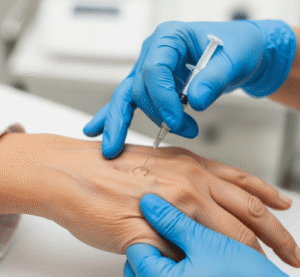What it is
Vaginal vault suspension is a surgical procedure to correct vaginal vault prolapse, a condition where the top of the vagina (vault) drops or collapses after a hysterectomy. Without the support of the uterus, the vaginal apex may lose stability and fall into the vaginal canal, often accompanied by bladder, bowel, or rectal prolapse.
This surgery re-establishes normal support for the vaginal vault using the body’s own ligaments, sutures, or synthetic mesh. In Korea, vaginal vault suspension is performed using vaginal, laparoscopic, or robotic-assisted techniques, ensuring precision, minimal scarring, and excellent long-term outcomes.
➡️ Key facts about vaginal vault suspension:
- Performed after hysterectomy when the top of the vagina sags
- Can be combined with repairs of bladder (cystocele) or rectum (rectocele)
- Aims to restore pelvic support, function, and quality of life
Why it’s done
Vaginal vault prolapse can significantly affect comfort, daily activities, and sexual health.
✔️ Medical reasons for surgery include:
- Vaginal bulge sensation or visible protrusion at the vaginal opening
- Pelvic pressure or heaviness worsening after standing or exercise
- Urinary problems (leakage, frequent urination, incomplete emptying)
- Bowel issues such as constipation or incomplete evacuation
- Painful intercourse or sexual dysfunction
- Prevention of worsening prolapse and complications
✔️ Benefits of vaginal vault suspension:
- Restores vaginal anatomy and function
- Relieves pelvic pressure and discomfort
- Improves bladder and bowel control
- Enhances sexual health and confidence
- Provides durable, long-term support
Alternatives
Before surgery, alternatives or conservative treatments may be considered.
🔹 Pelvic floor therapy:
- Kegel exercises, biofeedback, and electrical stimulation
- Useful for mild prolapse or post-surgery strengthening
🔹 Pessary use:
- Vaginal devices inserted to support the vault
- Non-surgical option for women not ready for or unable to undergo surgery
🔹 Lifestyle adjustments:
- Weight management, avoiding heavy lifting, and treating chronic cough
- Helps reduce strain on pelvic structures but does not reverse prolapse
🔹 Watchful waiting:
- Mild cases without symptoms may only require monitoring
Preparation
Preparation is important for a safe procedure and recovery.
➡️ Medical preparation:
- Pelvic exam and imaging (MRI or ultrasound) to assess prolapse severity
- Urodynamic testing to evaluate bladder function
- Blood tests and anesthesia consultation
➡️ Personal preparation:
- Stopping certain medications (like blood thinners) before surgery if advised
- Fasting before general anesthesia
- Arranging home support for initial recovery period
➡️ Mental preparation:
- Understanding fertility is no longer an issue after hysterectomy
- Preparing emotionally for temporary limitations after surgery
- Counseling may be offered to address concerns about intimacy and body image
How it’s done
In Korea, vaginal vault suspension is performed with advanced minimally invasive approaches for greater precision and faster recovery.
✔️ Surgical techniques:
➡️ Sacrocolpopexy (laparoscopic or robotic):
- The vagina is attached to the sacrum (lower spine) using synthetic mesh
- Provides strong and long-lasting support
- Considered the gold standard in many cases
➡️ Sacrospinous ligament fixation (vaginal approach):
- Vaginal apex sutured to the sacrospinous ligament
- Performed through the vagina, avoiding abdominal incisions
➡️ Uterosacral ligament suspension:
- Vaginal vault attached to the uterosacral ligaments for natural support
- Effective and avoids synthetic mesh use
✔️ Step-by-step procedure:
- Anesthesia (regional or general) administered
- Vaginal or abdominal incisions made depending on approach
- Vaginal vault lifted and attached to ligaments or sacrum using sutures or mesh
- Additional prolapse repairs (cystocele/rectocele) performed if necessary
- Incisions closed with sutures
✔️ Duration:
- Surgery usually takes 1–3 hours
- Hospital stay: 1–3 days for minimally invasive methods, longer for open surgery
Recovery
Recovery depends on the surgical method but is generally faster with laparoscopic or robotic approaches.
➡️ Immediate recovery:
- Vaginal soreness, pelvic pressure, or light bleeding
- Bladder catheter may remain temporarily after surgery
- Hospital monitoring for pain control and bladder function
➡️ Physical recovery:
- Return to light activities in 2–3 weeks
- Avoiding sexual intercourse, heavy lifting, and strenuous exercise for 6–8 weeks
- Full recovery within 6–8 weeks for most women
➡️ Emotional recovery:
- Relief from bulge sensation and urinary issues
- Some women may need reassurance when resuming sexual activity
- Counseling and support available in Korean hospitals for body image and intimacy concerns
➡️ Key recommendations:
- Adequate rest, hydration, and a high-fiber diet to avoid constipation
- Performing pelvic floor therapy after recovery to prevent recurrence
- Attending follow-up appointments to check healing and sling/mesh placement
Treatment option in Korea
Korea is highly advanced in urogynecology and pelvic reconstructive surgery, making it a top destination for vaginal vault suspension.
✔️ Hospital facilities:
- Equipped with robotic-assisted surgical systems for precision sacrocolpopexy
- Specialized urogynecology centers for prolapse and incontinence treatment
- Comfortable recovery rooms and advanced monitoring systems
✔️ Medical expertise:
- Surgeons highly skilled in both vaginal and laparoscopic/robotic suspension techniques
- Experience with complex prolapse cases and mesh-free repairs
- High success rates with low recurrence
✔️ Postoperative care:
- Integration of pelvic floor therapy into rehabilitation
- Counseling for sexual health, intimacy, and emotional well-being
- Long-term monitoring programs to detect recurrence early
✔️ Cultural aspect:
- Korean women’s health care emphasizes privacy, comfort, and dignity
- Post-surgery, many women benefit from Sanhujoriwon-style recovery centers, focusing on rest, nutrition, and rehabilitation
➡️ Highlight: Vaginal vault suspension in Korea offers state-of-the-art surgical precision, fertility-conscious care, and comprehensive recovery programs, ensuring women regain pelvic stability, comfort, and quality of life.


